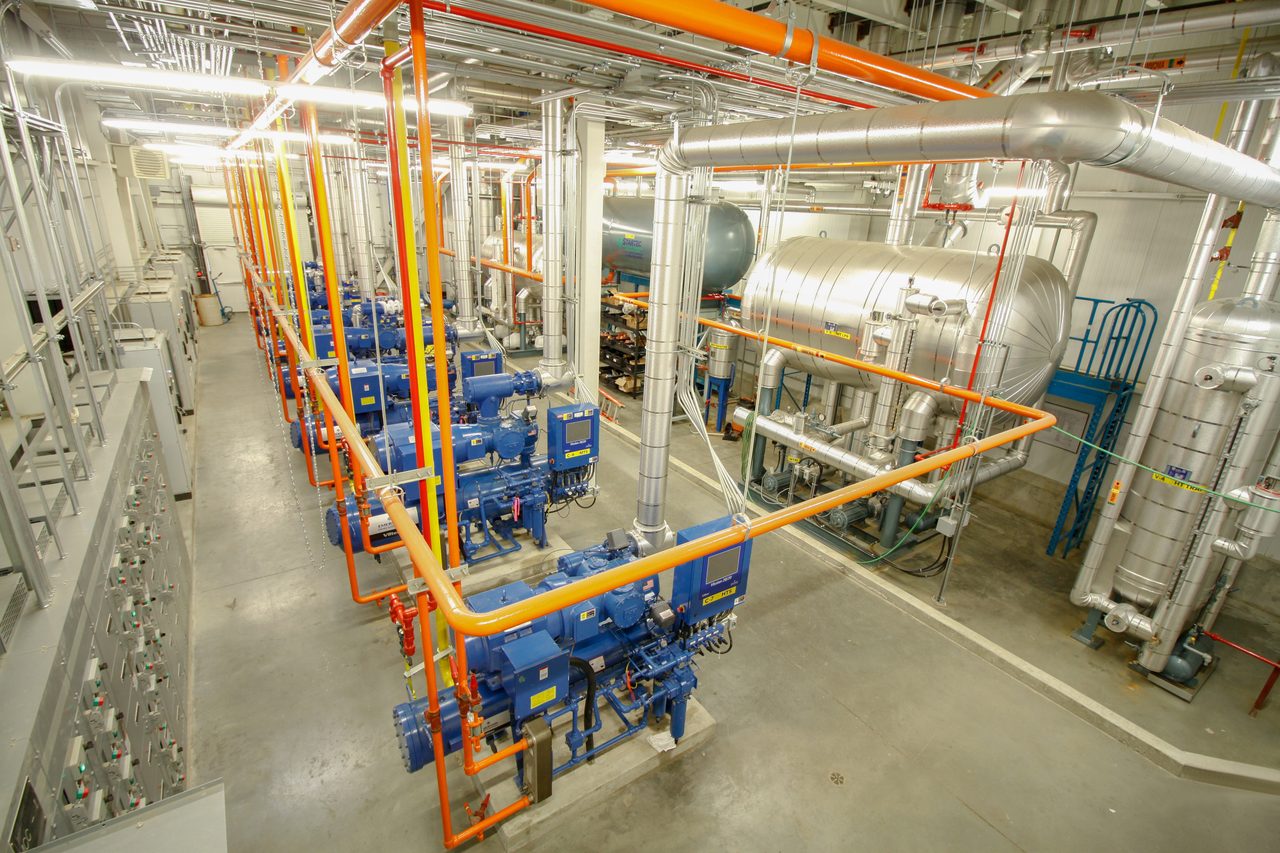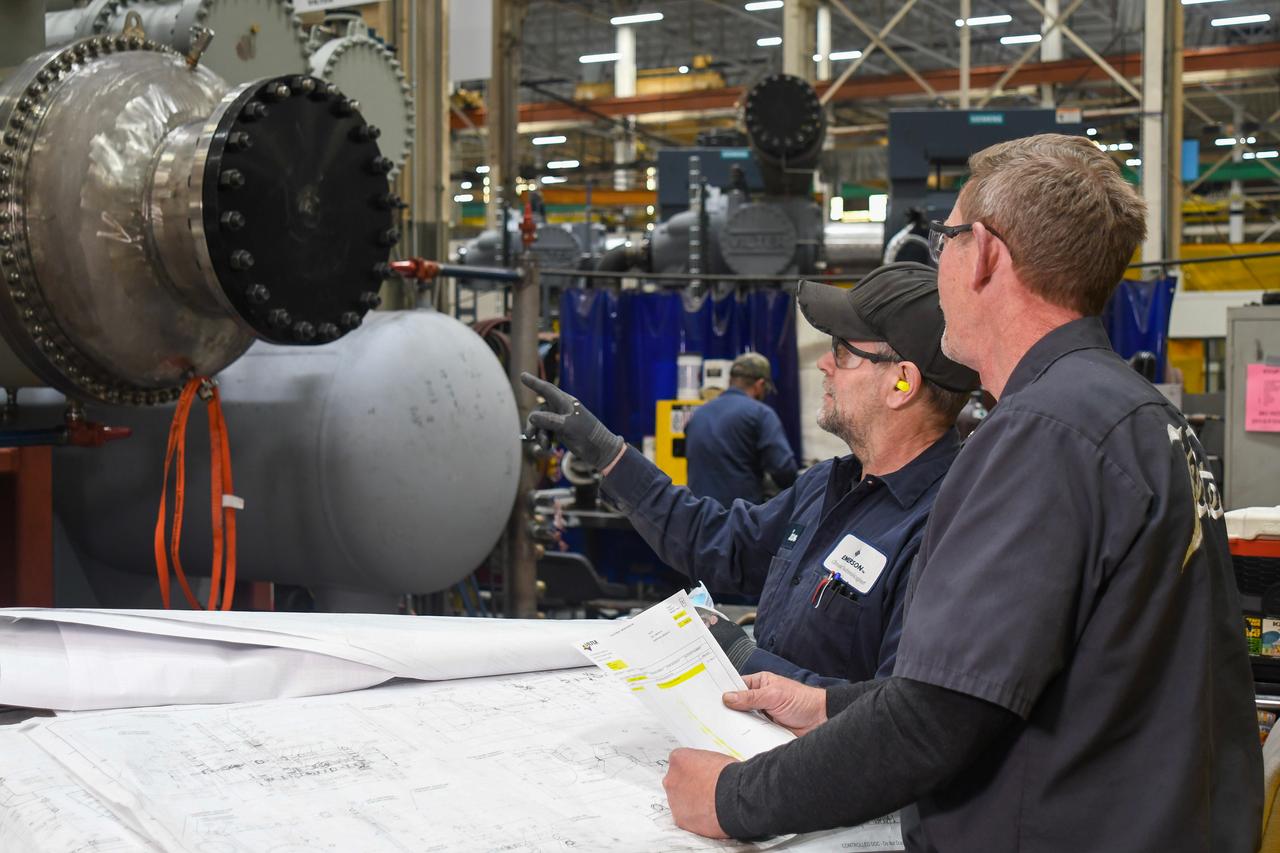

feature
Tracking the Evolution of Industrial Refrigerants
Exploring the emergence of CO2 in industrial cold storage applications.
2For decades, ammonia (aka NH3; refrigerant name R-717) has been recognized as the preferred refrigerant in low-temperature (LT) cold storage warehouses and light-industrial refrigeration applications. With excellent thermodynamic properties and an original equipment manufacturer (OEM) base to support it, this highly efficient workhorse is still used by most industrial facility operators. But, the tides are slowly turning in the industrial sector, and CO2 is emerging as a green, low-risk alternative to ammonia.
Despite its global adoption in commercial refrigeration over the past decade, CO2 has yet to make significant inroads in industrial refrigeration. Its high operating pressure and unique characteristics pose equipment design and system architectural challenges that have been difficult to overcome. However, the proven effectiveness of CO2 architectures widely used within commercial refrigeration — such as CO2 transcritcal booster and cascade systems — have provided the conceptual frameworks upon which industrial refrigeration system designers are building upon. In theory, it’s simply a matter of scaling these systems up for industrial use.
Industrial Market Drivers
Today, efforts to increase the supply of CO2-based industrial refrigeration equipment is driven largely by new market demands. Let’s look at some of the trends behind the renewed interest in using CO2 in industrial refrigeration.
Last-Mile Delivery Considerations: The COVID-19 pandemic has permanently changed consumer behavior, particularly in the accelerated adoption of e-commerce in food retail applications. This has led to the emergence of light-industrial distribution and fulfillment (D&F) facilities to shorten the distance between cold storage warehouses and consumers. But with these facilities now located in cities or more densely populated areas, the risk of an ammonia leak threatens to not only shut down the facility but also evacuate the surrounding area. Operators of these light-industrial facilities are seeking a lower-risk yet green alternative.
Lowering Ammonia Charges and Designing for Safety: Toxicity concerns, combined with the U.S. Occupational Safety and Health Administration’s (OSHA’s) safety requirements when operating systems that are charged with more than 10,000 pounds of ammonia, have prompted the industrial sector to seek refrigerant and system alternatives. This has led to exploring all-CO2 system architectures and those that combine CO2 and ammonia to lower the ammonia charge and move refrigeration circuits out of occupied spaces.
Global Hydrofluorocarbon (HFC) Refrigerant Phasedown: The recent passing of the American Innovation and Manufacturing (AIM) Act has brought the global HFC phasedown — as mandated by the Kigali Amendment to the Montreal Protocol — back into focus in the U.S. for both the commercial and industrial refrigeration sectors. Meanwhile, the California Air Resources Board (CARB) or U.S. Climate Alliance states are pushing forward with their own aggressive phasedown schedules. For those industrial operators who have traditionally preferred HFCs over ammonia and are looking for a refrigerant option that circumvents future regulatory entanglements, CO2 represents a safe, green refrigerant alternative.
Blurring of Lines Between Commercial and Industrial OEMs: Because CO2 and ammonia have historically played predictable roles in commercial and industrial refrigeration, commercial OEMs and industrial system providers have primarily stayed in their respective lanes. But with CO2 emerging in the industrial sector, and low-charge ammonia systems being trialed in commercial system architectures, commercial OEMs and industrial system providers are leveraging their experience with these refrigerants to cross into other markets. Industrial operators need to make sure OEMs understand the increased demands of their applications and select equipment that is built to withstand an industrial environment.
Sustainability Initiatives: Regardless of all other market and regulatory considerations, many companies today are bound by meeting corporate sustainability objectives, which requires selecting refrigeration architectures that are both safe and environmentally friendly. Regardless of potential installation caveats, end users seeking to leave a smaller carbon footprint are formalizing sustainability strategies that include the following objectives:
Deploying future-proof refrigerants with low global warming potential (GWP);
Designing high-efficiency systems; and
Constructing green facilities.
Natural refrigerants, like CO2 and ammonia, are helping businesses to achieve these objectives.

FIGURE 1: the dynamic regulatory landscape; rapidly changing market conditions; and the introduction of industrial-grade, CO2-based refrigeration equipment will likely make CO2 the most viable option in certain scenarios.
Image courtesy of Emerson
Emerging System Technologies
To help industrial cold storage operators contend with today’s market dynamics, OEMs and system providers are developing equipment and system architectures that are designed to utilize CO2 and lower charges of ammonia. Some of these architectures, like CO2 transcritical boosters, are based on existing system designs that are currently used in the commercial refrigeration space. Others seek to leverage ammonia and NH3/CO2 configurations in new system designs and through modifications of other existing refrigeration architectures. Regardless, their goals are to deliver high-tonnage refrigeration capacity suitable for industrial applications while utilizing CO2 and/or keeping ammonia charges low to mitigate safety concerns.
CO2 Transcritical Booster: CO2 transcritical booster systems offer an environmentally friendly, viable alternative to long-time owners/operators of HFC-based or traditional large-charge ammonia systems. By utilizing only R-744 for both LT and medium-temperature (MT) loads, this centralized refrigeration option allows operators to achieve compliance with future refrigerant regulations without introducing ammonia challenges. CO2 transcritical booster systems utilize several industrial compressors in parallel to meet the desired cooling requirement in cold storage warehouses or process refrigeration and are especially applicable in low-temperature applications (minus 40°F and below), like blast freezers. While the CO2 transcritical booster architecture has proven to be effective in commercial applications — especially in cooler regions — industrial installations require very large numbers of compressors. Recent advancements in CO2 single-screw compression technology are enabling this proven architecture to be used effectively on an industrial scale. CO2 transcritical booster systems utilize several industrial compressors in parallel to meet the desired cooling requirement.
NH3/CO2 Cascade: This architecture utilizes CO2 for low temperature and ammonia for high temperature and is an excellent solution for large, low-temp loads, such as blast freezing and cold storage. It builds on the proven record of ammonia for industrial applications — high energy efficiency including high ambient climates and reliable operation at lower pressures. In many cases, it’s possible to add low-temp capacity to an existing ammonia plant using a cascade system. For new installations, low-charge ammonia can reduce environmental concerns and utilize only CO2 in occupied spaces. Advances in heat exchanger designs allow for higher standstill pressures and virtually eliminate the risk of CO2 leaks into the ammonia system.
Smaller Platform Applications for Ammonia: Light-industrial operators with smaller facilities have many low-charge ammonia options to meet their cooling requirements and sustainability goals. Systems include:
NH3 low-charge distributed: This remote, distributed architecture is designed to reduce the liquid line length and subsequent ammonia refrigerant charge. The system utilizes a compressor skid in a smaller engine room and a liquid receiver located on the roof directly above the evaporators (liquid overfeed);
NH3 direct expansion: Available in distributed or remote varieties, this system requires the circulation of much less refrigerant compared to the liquid overfeed method;
NH3 chiller with pumped CO2 secondary: This system is designed to utilize both NH3 and CO2, where the ammonia is used to chill CO2 (volatile brine), which is then pumped into the refrigerated areas of a facility; and
NH3 chiller with pumped CO2 secondary plus CO2 cascade: This system combines an NH3 chiller that provides the MT load via a CO2 secondary design plus a CO2 cascade system for the LT side.
For the most part, these smaller-platform architectures are mainly being deployed in trials to determine their effectiveness and viability. Companies that seek a lower-charge ammonia system or want to transition away from HFCs are actively working with OEMs to explore their options. This ongoing evolution will continue to drive OEM innovation to develop a greater diversity of options to meet end users’ specific requirements.
Supporting the transition to CO2
Due to the widespread adoption of and familiarity with ammonia in large-charge industrial systems, it’s unlikely CO2 will ever completely replace ammonia as the preferred refrigerant in the industrial sector. However, the dynamic regulatory landscape; rapidly changing market conditions; and the introduction of industrial-grade, CO2-based refrigeration equipment will likely make CO2 the most viable option in certain scenarios.
Emerson’s Vilter™ single-screw compression technology is not only built to withstand the rigors of industrial refrigeration, but it’s also capable of managing the high pressures of CO2 transcritical booster applications. With fewer moving parts than reciprocating compressors and higher energy efficiency ratings than twin-screw compressors, a single-screw compressor delivers longer life and higher reliability, regardless of the type of refrigerant used.
CO2 and Ammonia — Side-By-Side
CO2 and ammonia are among the most eco-friendly, natural refrigerant alternatives available. OEMs continue to seek ways to exploit their efficiencies and mitigate their risks.
Ammonia
0 GWP and 0 ozone depletion potential (ODP);
Low pressure, toxic, and slightly flammable;
Workhorse in cold storage, industrial refrigeration;
Architectures are now evolving to utilize lower charges used, preferably removed from occupied spaces; and
Extremely efficient in a wide range of temperatures.
CO2
1 GWP and 0 ODP;
High-pressure, low critical temperature, and high triple point;
Nontoxic, nonflammable, very minor leak threat;
Foothold in commercial refrigeration as alternative to HFCs; and
Effectiveness in low temperatures; making inroads in industrial applications
Lee Van Dixhorn
Lee Van Dixhorn is the director of solutions development, Vilter, Emerson.
